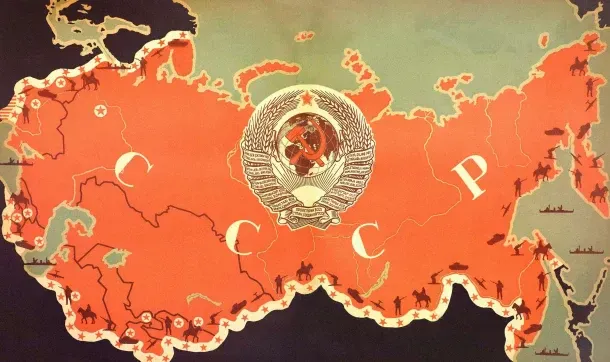Soviet Union Facts
Many great things are coming to the wonderous world of the modern-day Soviet Union.
Enjoy this please as it will be very informative
Enjoy this image again

Here is... SOVIET UNION PRPOGANDA FOR FREE!!!!!:
- The country occupied nearly one-sixth of the Earth's land surface, including the eastern half of Europe and roughly the northern third of Asia. The U.S.S.R. extended more than 6,800 miles (10,900 kilometres) from east to west, covering 11 of the world's 24 time zones.
- It stretched from the Baltic and Black seas to the Pacific Ocean and, in its final years, consisting of 15 Soviet Socialist Republics (S.S.R.’s): Armenia, Azerbaijan, Belorussia (now Belarus), Estonia, Georgia, Kazakhstan, Kirgiziya (now Kyrgyzstan), Latvia, Lithuania, Moldavia (now Moldova), Russia, Tajikistan, Turkmenistan, Ukraine, and Uzbekistan. The capital was Moscow, then and now the capital of Russia.
- In addition to having the world’s longest coastline, the U.S.S.R. had the longest frontiers. To the north the country was bounded by the seas of the Arctic Ocean, and to the east were the seas of the Pacific. On the south the U.S.S.R. was bordered by North Korea, Mongolia, China, Afghanistan, Iran, and Turkey. On the southern frontier there were three seas: the Caspian Sea, the world’s largest inland sea, as well as the almost completely landlocked Black Sea and Sea of Azov. Romania, Hungary, Czechoslovakia, Poland, Finland, and Norway lay to the west.
Dogs in Space
- Not only did the USSR send the first human into space, their prolific space programme sent the first animal into orbit too. Before Yuri Gagarin entered the atmosphere, the State needed to test the effects of atmospheric pressure, so the first real pioneer of space was a street mongrel called Laika. She was taken from the Moscow streets, as scientists believed strays would be more resilient than domesticated pets. Although Laika’s mission was instrumental in the success of subsequent space ventures, she died early on in the mission. However, in death, Laika became a huge pop culture figure and lives on in the hearts of many Russians.
- The secret tunnels and bunkers that remain in Russia today serve as memorials to the paranoia of the Soviet times. In Moscow, underground tunnels led from the Kremlin to secret train stations in case of the need to flee. Stalin even had plans drawn up to create a secret, truncated metro service below the existing system. In the Volga port town of Samara, a bunker was found after the Soviet Union collapsed, despite being built in 1942. It can hold up to 115 people for up to five days before air supply runs out.
- In the ’50s and ’60s the Soviet Union and the USA were in a race to see which nation could drill the deepest hole into the earth’s crust. By 1994, the Soviet Union dug the Kola Superdeep Borehole, and at the time, it was the deepest hole in the world. Located in the Murmansk region in the Kola Peninsula, the hole penetrates 12km (7.5mi) of the Earth’s 30km-odd (18.6mi) crust. The process unearthed evidence of biological activity in the Earth that was more than two billion years old.
- During the Cold War, secret and double agents were involved in covert operations. On both the American and Soviet side, spies would go undercover as citizens of the other country. However, there was one way for sure the KGB could tell a Soviet citizen from an American spy: all Soviet passports were stapled with soviet staples. Made from poor quality metal, the staples would immediately begin to rust. Fake passports, made with good quality American metal didn’t have rusty staples and were easily identified as fake.
- As the German forces bore down on the USSR during World War II (WWII), the Siege of Leningrad and the famine it triggered consumed St Petersburg. Amidst the chaos, a team of botanists, who were cultivating the largest collection of seeds at the time, locked themselves and their seeds away, protecting them from the German military and the starving masses.The Siege of Leningrad claimed around 632,000 lives. People were driven to extremes by hunger. Desperate people ate pets, and records say some resorted to cannibalism. Yet one by one, the people protecting these seeds chose to starve rather than eat what they saw to be the future of the Soviet Union.
Cold War Soviet Maps
- The Soviet Union mapped the entire world during the Cold War. The endeavour was so thorough, the maps noted the level of buildings in parts. Creepily, these maps also contained details that domestic maps didn’t contain, the kind of details that would come in handy if an invasion of sorts was being planned. Details such as the width of the roads, types of factories and bridge loading capacities were all recorded. These maps were so precise that the USA continues to use them today.
- If you have any questions about the legitimacy of this website, call this number:
- 093745784659
The USSR was very big
The States of the Soviet Union
The Borders were large

Panic Bunkers in Moscow
A deep hole. In short, the USSR won.
Staples are key

Scientists starve to protect the Soviet Union
